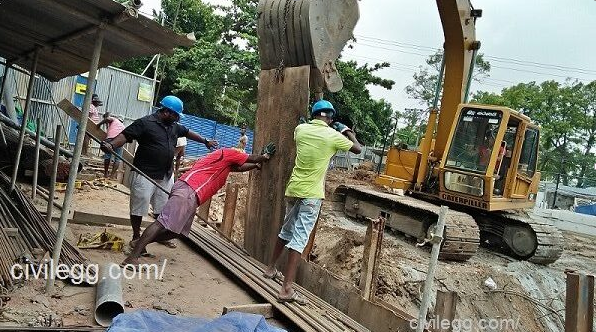Shoring in construction is used to support a deep excavation to prevent the retained soil from overturns and eventually cause a project mishap. Depending on the soil type; shoring support is usually provided when we need to support an excavation with at least 1.2 meter high. In this article, we have discussed the types of shoring in construction.
Read more about; Construction tools
Types of shoring
The common types of shoring that we
usually encountered in the construction project are;
- I-Beam Shoring
- Secant Piles Shoring
- Contiguous Pile Shoring
- Sheet Piles
- Diaphragm Walls
I-Beam Shoring.
Also known as soldier pile walls;
are the most common type of shoring that we usually encountered in a
construction project. It is constructed by driving prefabricated steel I
sections into the ground.
Soil conditions may allow for the
sections to be vibrated directly into the ground instead of pre-drilling of
soil before installing the beam.
The full wall is formed by
installing a precast concrete panel between the driven steel beams to construct
the shoring walls.
Additionally, I Beam Shoring is used
to support an excavation ranging from 1.2 to 5 meters deep or excavations
equivalent to at least one basement; and depending on the design; its toe
length ranges from 10 meters to 12 meters depth from 0 levels.
Secant Piles Shoring
Secant Pile Shoring was formed of
intersecting two combinations of piles; with a “reinforced” also called as
secondary and “unreinforced” or; primary pile interlocking each other to form a
continuous wall.
A guide beam is constructed first
prior to installation to keep the alignment in place.
This is usually used in deep
excavations.
After casting the “primary” pile;
the temporary casing is extracted while the concrete has not fully set and a the heavy casing is then driven into the intervening pile location cutting into the
fresh concrete of the adjacent pile.
The “secondary” piles are then
immediately drilled.
The steel cages of the “secondary” pile
are inserted and the structural concrete is poured to form a continuous wall.
Secant Piles are the best choice to
use when there is no room for open excavation or when space is limited because
of an existing structure that is too close in proximity.
Types of shoring in construction
Contiguous Pile Shoring
Contiguous or Tangent Pile Shoring
is composed of closely spaced piles wherein the faces of the piles are almost
touching or tangent with each other.
This is used in areas where water is
not significant or the water pressure is very minimal. This is usually proposed
in clay soils and can use to retain dry granular material or fills.
Although water seepage between the
gaps of the pile is more likely to occur when using in water-bearing granular
soils, it can be prevented by grouting these gaps to form a watertight
retaining wall.
This type of shoring is not
recommended to use in a high groundwater table without dewatering works.
Construction of contiguous pile is
very similar to that of the secant piles as prior to the installation; a guide
beam should be constructed to serve as a guide for the contiguous wall to
install in place.
Sheet Piles
Although can be used to retain soil
to soil excavations. This type of shoring is bests to use when we need to
isolate our excavation from the bodies of water specifically a creek; a pond,
or on a seaside.
It is commonly seen in a port and
harbor construction.
Similar to soldier piles, it can be
constructed by driving prefabricated Z or U steel sections into the ground
using a "vibro" hammer.
The full wall was formed connecting
the Z or U steel sections or the sheet piles.
Depending on the depth of
excavation, the end of the sheet piles if not long enough can be welded
together to reach the desired depth in the ground.
Diaphragm Walls
When the excavation is too deep for
the above-mentioned type of shoring, diaphragm walls can be used. It is
installed in three panels of reinforced concrete installed and concreted at the
site.
It can be a load-bearing element for
a temporary or permanent retaining wall or both.
For the deep excavation of the
basement and tunnels; the diaphragm wall is the best option.
Check also; Principles of the taking off quantities


![Measurement Sheet for Interim Bill [excel format]](https://blogger.googleusercontent.com/img/b/R29vZ2xl/AVvXsEgno3lex-yqlKV9m7-73bno0XRwo_QIdIMLOx2jBgcKScuGLRIHTEhVHNljWj-0iiL-4HMUXrtHsHZrKEY5J_VXArBRlmquEIROY1GsL0VaU3udEfoOSBUYo1CxLYaHheqEC2lPU1s13NTW/s72-c/measurement+sheet+.png)


No comments:
Post a Comment